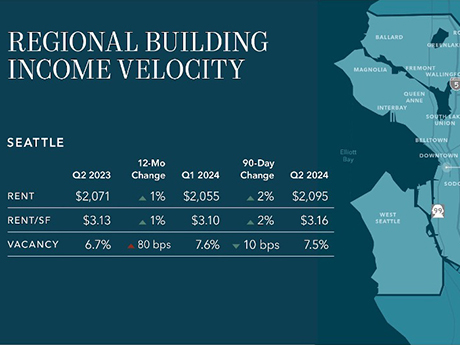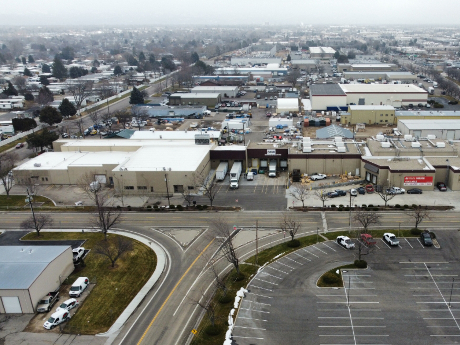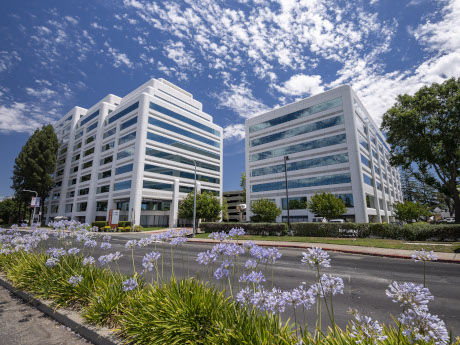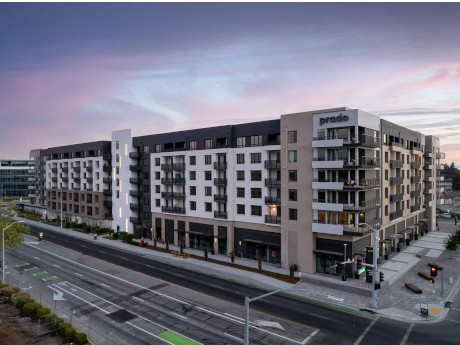— Jason Hallahan, associate of Colliers Reno — Northern Nevada’s office market has shown continued resilience in 2024 as the region has seen robust tenant demand, fewer sublease availabilities and evolving market trends. Though Northern Nevada experienced an influx of vacant space that hit the market in the middle of the year, year-to-date tenant demand has been largely positive. Robust absorption in the first and third quarters of 2024 has driven annual net absorption to more than 77,500 square feet. While many larger office markets felt an immediate impact at the onset of the pandemic, Reno’s office market began to see the wave of sublease space hit the market at the start of 2022 — nearly two years later. At its peak in the first quarter of 2023, available sublease space accounted for 28.2 percent of all available space on the market. Northern Nevada’s sublease market has continued to shrink over the past two years as the total square footage recently dropped below 90,000 square feet. This is less than one-third of the 2023 peak, which was 303,000 square feet of available sublease space. This loss of sublease space is due to large sublease suites being occupied by new subtenants, …
Western Market Reports
— By Ben Galles, senior vice president of CBRE — Interest rates have been the biggest factor for Reno’s multifamily market this year, reaching some of the highest levels seen in a long time. The market for multifamily properties in Northern Nevada has been slow to adjust to the new lending environment, with sellers unwilling to price assets at a rate of return that would provide most buyers with positive leverage. In other words, the interest rate on loans used to purchase many of the current listings is higher than said property’s cap rate. Multifamily sales volume in Northern Nevada is down 14 percent compared to the same time last year. One of the major drivers for the drop in sales volume is that only three deals have secured bank debt, with the average loan to value (LTV) of those loans being roughly 48 percent. While cash transactions have represented more than 58 percent of the transactions, a large percentage of deals have involved owner financing. Some owners who needed to move their assets over the past 12 months found that offering below-market interest rate owner financing was a significant selling point. Many of the deals that closed with owner …
— By Dylan Simon, executive vice president, Kidder Mathews — This summer marked a major milestone in Seattle’s apartment market, demonstrating signs of vibrancy with increases in rental rates, growing liquidity and clarity in pricing in capital transactions. The city is gaining momentum and continues to bounce back from recent market fluctuations and the harsh impacts of the pandemic. Urbanization is here to stay — corporate employers are voting against Zoom as an effective tool — as we trend back toward human nature, which requires community and proximity. With limited new construction breaking ground, the stage is set for sustained rental rate growth, which will invariably result in a surge in sales prices. Transaction Activity on the Rise Transaction activity is steadily on the rise in Seattle’s multifamily market, proving conviction from the investment community. This uptick offers greater clarity on property values as the market adjusts from peak interest rates back in fall 2023. For owners and potential sellers, this shift suggests pricing hit a bottom in the past nine months and the only direction in pricing from here is upward. In our recently launched third-quarter Seattle market report, we’ve uncovered key sales insights that underscore this resurgence. During the …
— By Leah Masson, senior director, Cushman & Wakefield — The real estate landscape in the Puget Sound region is shaped by a dynamic contrast between the Eastside and Downtown Seattle. The Eastside continues to thrive, particularly with its robust tech activity. Major developments, such as the Eight, Skanska’s 540,000-square-foot project, is nearing full occupancy, underscoring the area’s strong demand. OpenAI is actively seeking space on the Eastside, with expectations of more artificial intelligence groups to follow. It’s worth noting that the Eastside is not plagued by the safety issues that have been a concern for Downtown Seattle. The anticipated 2025 opening of the light rail is set to drive even more growth in the area. Downtown Seattle is also experiencing an uptick in leasing activity, with active tenants expanding in terms of both square footage and lease term lengths. Since 2021, professional services groups, such as law and engineering firms, have been the primary drivers of leasing, but there is now a welcome return of tech companies to the Seattle market. New AI-focused tenants are beginning to emerge, moving out of coworking spaces and seeking permanent office locations in the city. However, Downtown Seattle continues to face significant challenges, …
— By R.J. Vara, first vice president of investments, Marcus & Millichap’s The Vara Group — The Seattle industrial market is undergoing a transitional phase marked by rising vacancies, fluctuating demand and evolving investment dynamics. There was a robust surge from 2020 to 2022, which saw nearly 19 million square feet of industrial space absorbed and more than $8.4 billion in transaction volume. However, the market experienced a reversal in 2023, with roughly 2 million square feet of previously absorbed space becoming available. This shift, driven by decreased container traffic at local ports, rising interest rates and elevated inflation, has continued into 2024, with speculative construction projects contributing to elevated vacancy rates. As of mid-year, Seattle’s industrial vacancy rate has increased by about 2 percent year over year, reaching 7.7 percent. This has surpassed the national average of 6.6 percent. The rise in vacancies is primarily attributed to the completion of new distribution facilities, with spaces of more than 100,000 square feet now available in double digits. Delivery numbers are expected to fall to their lowest level since 2017, but investors are beginning to explore opportunities in the southern regions. Regarding investment activity, Seattle’s industrial sales volume has notably increased …
— By Jacob Pavlik, research manager, Colliers — A 10-mile drive east of Seattle, Bellevue is the top destination for urban retail activity in the Puget Sound. High incomes, healthy daytime employment and the most active office leasing market in the Pacific Northwest means not much more is needed to make a retail space thrive. That is, except reasonable fit-out costs for new space. The Bellevue CBD has seen significant new construction for office buildings (with lots of ground-floor retail opportunities), delivering 3.3 million square feet over the past year alone. Unfortunately, sky-high construction pricing and office market financing challenges have made it difficult to get retail leases done in new buildings. Second-generation spaces in the submarket are the reasonable but diminishing alternative. Second-generation spaces are filling up faster than they become available. The demand is partially from tenants whose buildings were torn down for redevelopment. Given the cost of fitting out a space in a brand-new building elsewhere in the Bellevue CBD, second-generation space is the most lucrative alternative. First-generation space, which delivers as a cold shell without HVAC, plumbing or dry wall, can cost upward of $400 per square foot to build out. Landlords tend to offer $100 …
— By Devin Pierce, industrial specialist, TOK Commercial in Boise — In recent years, Boise’s industrial market has become a focal point for investors and developers drawn to the region’s economic growth and location. With demand for industrial space on the rise, the market has experienced an unprecedented wave of new construction aimed at meeting the needs of both local businesses and national tenants looking to expand their operations. This surge in development activity reflects Boise’s growing prominence as a logistics and manufacturing hub. However, as new projects come online, the market is also grappling with the challenges of balancing supply and demand, particularly in the wake of fluctuating economic conditions. Speculative Construction Drives Vacancy Surge Boise’s industrial market saw a considerable number of projects completed during the first half of 2024, with more than 2.2 million square feet of new construction delivered. Speculative construction accounted for more than 86 percent of these projects, totaling nearly 2 million square feet and marking a record high for mid-year. Top spec projects included nearly 1 million square feet at Red River Logistics Center; three new buildings (totaling 292,000 square feet) at Park84 in Nampa; and 396,000 square feet at Sky Ranch Logistics. This …
— By Colin Yasukochi, executive director, Tech Insights Center, CBRE — An increasing supply of distressed properties for sale has been met with enthusiasm by a growing number of opportunistic buyers in San Francisco. Prices up to 70 percent lower than the seller’s cost basis, combined with improving fundamentals, has given investors confidence to make property purchases ahead of substantial leasing market recovery. About $1 billion of office sales volume could be reached by year-end 2024. There are 27 properties totaling 3.6 million square feet that have sold (totaling $338 million), are under contract (totaling $193 million) or being marketed ($453 million). If this occurs, it would be the highest number of properties sold since 2019 and the highest square footage and dollar volume since 2021. The years 2022 and 2023 combined had a total sales volume of $945 million. Stabilization in the office leasing market has emerged with vacancy and rents little changed and much higher space demand. Second-quarter 2024 vacancy ticked up to 36.8 percent (+0.1 percent), while average asking rents ticked down to $68.43 (-$0.12) compared to the previous quarter. Demand indicators strengthened with leasing activity and tenants in the market rising in the second quarter of …
— By Dustin Dolby, executive vice president, Colliers — During the second quarter of 2024, the San Francisco multifamily market endured high interest rates and delayed cuts. Between June and December of 2023, expectations of the Federal Reserve cutting rates spurred an increase in transactional activity following an apparent lull in the first quarter of 2023 as interest rates remained elevated. This two-peat of complacent transactions can be attributed to the looming decision concerning interest rate trajectories and its projections. Upon reaching the second quarter of 2024, we have yet to see any such cuts applied. This — along with the Federal Reserve’s consistent reluctance to cut — has resulted in a plateau of transactional volume within the San Francisco multifamily market. Development within the San Francisco submarket has faced similar stagnation. However, this can be attributed to a lengthy “shot clock” that new developments face regarding the city approval process. Because of this, projects that focus on a large percentage of affordable units have been streamlined and comprise the bulk of new developments in the market. If the Federal Reserve lowers interest rates by the end of the third or fourth quarter of this year — as anticipated in its …
— By Rachel Ivers, senior analyst, multifamily investment sales team, and Bryan Danforth and Matt Thomson, senior vice presidents, Compass Commercial — The multifamily investment sales market in the San Francisco Bay Area is undergoing a noticeable transformation that’s driven by economic pressures and evolving investor strategies. Unlike in previous years — where sellers might list properties to capitalize on market highs or interest rate lows — the current environment is seeing fewer sales motivated by profit. Many sellers today are cashing out due to expiring fixed interest rates or selling for personal reasons rather than purely financial motivations. This includes circumstances such as inheritance, divorce or retirement. With the Baby Boomer generation, currently aged 60 to 78 and reaching retirement age in larger numbers, we’re beginning to see the front end of significant changes in property ownership. This demographic shift is likely to drive a substantial increase in inheritance sales in the near future as life expectancy hovers around 77.5 years. A significant factor driving this shift is the belief among many investors that the market has peaked. Concerns about stricter rent control measures, which continue to appear on ballots, are prompting these investors to seek opportunities elsewhere. Markets …





